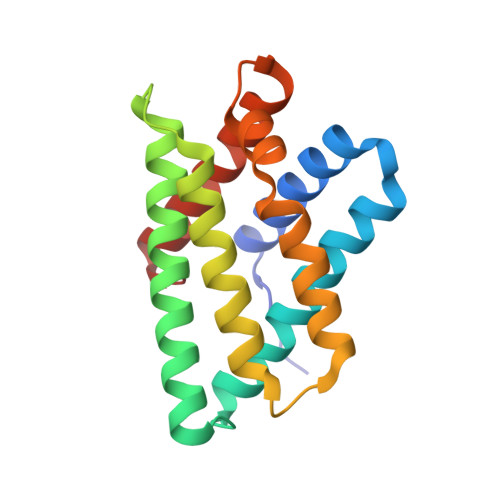Structural insight into TIPE1 functioning as a lipid transfer protein.
Cao, S., Zhang, Y., Jiang, H., Hou, X., Wang, W.(2023) J Biomol Struct Dyn 41: 14049-14062
- PubMed: 36898854
- DOI: https://doi.org/10.1080/07391102.2023.2187641
- Primary Citation of Related Structures:
8GYN - PubMed Abstract:
As a member of the tumor necrosis factor-α-induced protein 8 (TNFAIP8/TIPE) family, TIPE1 has been found to be associated with many cellular signaling pathways in regulating apoptosis, autophagy, and tumorigenesis. However, the position of TIPE1 in the signaling network remains elusive. Here we present the crystal structure of zebrafish TIPE1 in complex with phosphatidylethanolamine (PE) at a resolution of 1.38 Å. By comparison with structures of other three TIPE family proteins, a universal phospholipid-binding mode was proposed. Namely, the hydrophobic cavity binds to fatty acid tails, while 'X-R-R' triad nearby the entrance of cavity recognizes the phosphate group head. Using molecular dynamics (MD) simulations, we further elaborated the mechanism of how the lysine-rich N-terminal domain assisting TIPE1 to favorably bind to phosphatidylinositol (PI). Beside small molecule substrate, we identified Gαi3 as a direct-binding partner of TIPE1 using GST pull-down assay and size-exclusion chromatography. Analyses of key-residue mutations and predicted complex structure revealed that the binding mode of TIPE1 to Gαi3 could be non-canonical. In summary, our findings narrowed down TIPE1's position in Gαi3-related and PI-inducing signaling pathways.Communicated by Ramaswamy H. Sarma.
Organizational Affiliation:
Advanced Medical Research Institute, Interventional Medicine Department, The Second Hospital, Cheeloo College of Medicine, Shandong University, Jinan, China.















